LG V60 ThinQ Review
LG V60 ThinQ Review
A surprisingly impressive phone
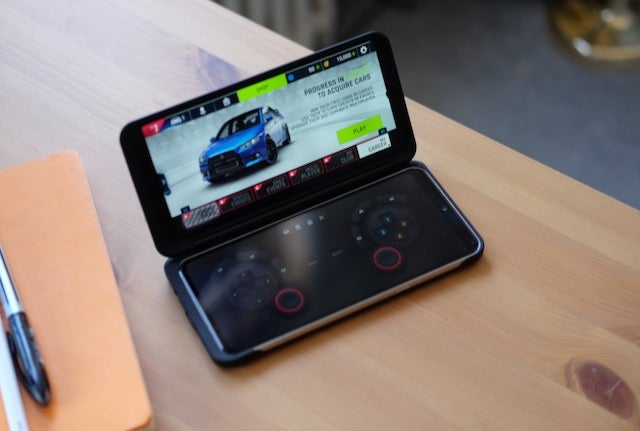
Verdict
The LG V60 ThinQ has not got an official UK release, so getting hold of one is a little tricky. Still, if one is available in your region, then it can prove cheaper than the Galaxy S20 Ultra, especially in the States where the price is $950. For that, you get a good phone with a fun Dual Screen add-on, 5G, performance that mostly matches the competition and a strong camera. It does feel like LG needs a bit of reset with its flagship phones though and we might just get that with the LG Velvet.
Pros
- Great battery life
- A screen that isn’t curved
- Reliable cameras
- A headphone jack
- Some clever Dual Screen uses
Cons
- The screen just can’t compete with other Android flagships
- Still not convinced by the Dual Screen
- Not the most ergonomic
- LG's software needs a reboot
Key Specifications
- Review Price: £TBC
- Dual screen add-on
- Snapdragon 865 and 5G support
- 5000mAh battery
- 64MP main camera
The LG V60 ThinQ might not be as flashy as some of the other best phones around, but this is a surprisingly impressive phone – if you look past a few details that feel stuck in the past.
LG’s flagship phones have felt a bit stuck for years, which is why the recent announcement of the new LG Velvet line felt like the reboot they needed.
The LG V60 ThinQ is the perfect example: it manages to do a lot very, very well; however, there are some odd omissions and some areas (software especially) that need a thorough rethink.
Design – The LG V60 ThinQ is a big phone
If you’re keen to upgrade to a phone that isn’t huge, then I think it needs to be made clear immediately the LG V60 ThinQ isn’t for you. This is a brute of a device that feels bigger than the Galaxy S20 Ultra due to its lack of curves and far more squared-off design. It’s also not as modern as the latest Galaxy series, with thicker bezels around the display and a teardrop notch that lacks a high-end finish.
It’s a lot more industrial than most of the overly curvy 2020 flagships though, and that’s not really a bad thing. Once you get used to the size, it’s quite a nice phone to look at. My review unit has a pearly blue back with a soft gold rim that offers a nice contrast. It feels durable enough to handle a few drops before picking up too much damage.
Along the side of the phone, you’ve got quite a lot of buttons, with a dedicated Google Assistant key sitting alongside a split volume rocker and power button. It seems a waste to have a whole button just for opening the assistant – couldn’t think this just have been achieved with a long-press of the power key?
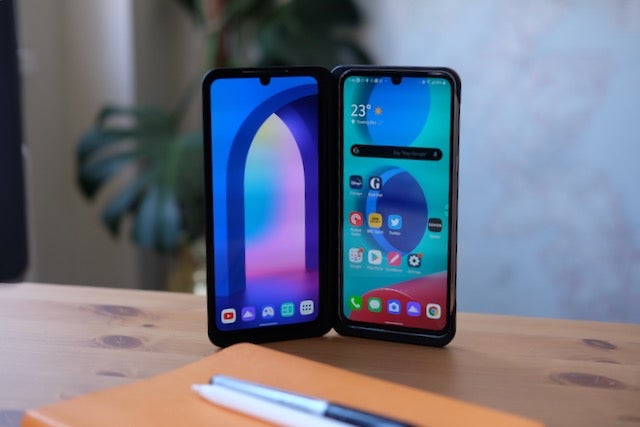
On the top, you’ve got the 5G capable SIM slot which also houses the expandable storage, and on the bottom, there is both a USB-C port and a 3.5mm headphone jack. Yep, this is one of the few high-end phones that still have the port for plugging a pair of wired headphones.
Screen and Dual Screen – This is what sets the LG V60 apart
Picking the most intriguing feature of the LG V60 ThinQ is easy: the Dual Screen addition. This included accessory functions just like it did on the LG V50 and LG G8X, adding a second panel to the device to create a sort of DIY Surface Duo. While the extra screen is the main benefit, the Dual Screen add-on also adds some extra protection to the phone’s display and a handy screen on the front for checking time and notifications.
Attaching the Dual Screen is easy as the phone just slides in and clips into the USB-C port. While the headphone jack remains visible, the case covers up the outer USB-C port and replaces it with a magnetic connector. To counter this, LG has included a magnetic dongle that clips onto the bottom and allows you to then connect a USB-C cable to charge the phone.
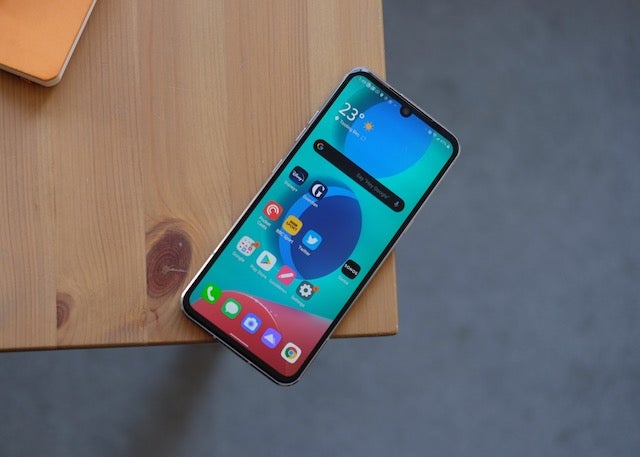
The Dual Screen is certainly an interesting addition to the phone. It adds a bunch of clever, and surprisingly fun, features from turning it into a gamepad for supported games like Asphalt 9 to just giving you more screen real-estate for multitasking. For instance, you can have YouTube open on one screen and Chrome on the other.
LG had decided to keep the two screens very much the same, which is good when using them together but limits the panel on the phone. Both are good, flat 6.8-inch OLED panels, with FHD+ resolutions and great colour reproduction. However, the resolution isn’t as crisp as much of the high-end Android competition, and the lack of a 90Hz or 120Hz refresh rate is certainly noticeable if you’ve had any time with the Samsung Galaxy S20 or OnePlus 8.

LG has even gone as far as mirroring the notch on the secondary panel – even though it doesn’t house a secondary front camera. This seems odd, but it allows for the two panels to mirror each other exactly, which actually makes more sense in use.
The one trick you’ll only find on the main display is the in-display fingerprint scanner. Like other optical fingerprint sensors, the one here is good, if not as good as a physical sensor. It can be temperamental, at times not unlocking for a run and then working instantly at others.
While I like the Dual Screen and it does add a much-needed unique flair to the V60, it’s not something I can keep on all the time. It’s too thick and adds more weight to an already weighty phone. It’s a halfway house to the foldable future that really needs to be built into the phone for it to properly work.
Camera – The LG V60 can compete with the best, if not beat them
Like much of this phone, the LG V60’s camera setup is good – if not exactly class-leading or unique. On the back, you’ve got a main 64-megapixel sensor with an f/1.9 lens that shoots, by default, 16-megapixel snaps alongside a 13-megapixel f/1.9 ultra-wide camera. There’s also a 10-megapixel camera on the front for selfies.
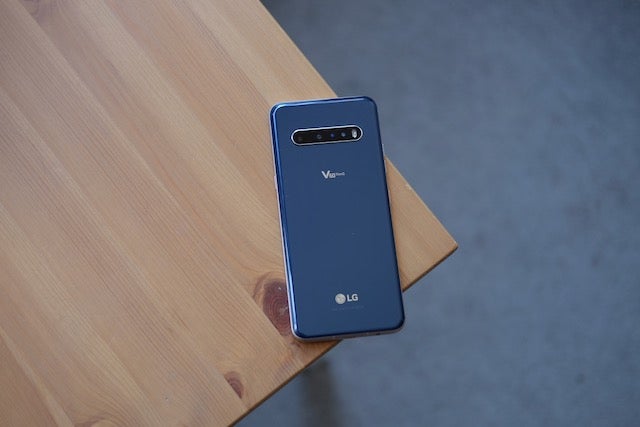
Only having two main cameras means the V60 ThinQ isn’t quite as versatile as some of the competition and the fairly basic zooming capabilities are nothing to shout about.
Yet, the pictures the phone captures are actually really nice. It feels like LG has decided to go against the trend and not go too deep with post-processing and heavy HDR effects. Shots are naturally coloured, with subtle saturation and good dynamic range. This leaves you with pictures that are ready to be edited or tweaked as you see fit. Low-light shots follow a similar pattern and even though there is more noise and less detail than similar shots taken with the Galaxy S20, the results are still good.
What I really like about LG’s camera app is the manual mode, which is both easy to use and packs the ability to shoot some impressive macro shots with manual focus.
In terms of video, the V60 ThinQ continues to perform well and packs a four mic array and the ability to capture 8K footage in HDR 10.
Performance and software – Great performance, disappointing software
Inside the LG V60 ThinQ, you’ll find the guts of your typical Android flagship: Snapdragon 865 with 5G modem, 8GB RAM and up to 256GB of internal storage. As you’d expect from those specs, this is a fast phone that can handle any game or app with ease and doesn’t get bogged down – even if you’re using both screens with separate apps on both.
For those that want benchmarks scores, the V60 scores around the same as the OnePlus 8 Pro and both phones feel very similar in terms of performance. Opening up Asphalt 9, for example, took the same amount on both phones.
Audio performance is impressive too, with both the 3.5mm port and onboard speakers pumping out some great sound. I don’t really mind when a phone has lost the headphone port, but I still always enjoy having it back when it’s there.
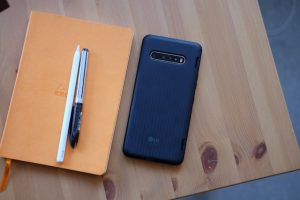
What’s less impressive is the software layer, LG keeps putting over the top of Android. Here, Android 10 is covered by a gaudy skin with loads of duplicate apps and a generally old-fashioned feel. Samsung switched things up massively with its One UI and I feel LG needs to do something similar.
Battery life – Where the LG V60 ThinQ shines
It is when you use the LG V60 ThinQ over an extended period that you start to forgive the lack of real top-drawer specs. The 5000mAh paired with 1080p resolution display leaves you with some of the best battery life on any high-end Android phone.
With the Dual Screen attached and used consistently, the V60 ThinQ made it through a full day of use. Take the attachment off, and you’ll, predictably, see even better results. I managed to get through two days of use with near 7 hours of screen on time before feeling the need to reach for the charger. That’s impressive stuff.
When it does reach 0%, there’s support for Quick Charge 4+ and PD 2,0 along with wireless charging. Admittedly it’s far from the fastest phone to charge out there and is comfortably beaten by rivals like Oppo with the Find X2. A full wired charge took just less than two hours.
Should you buy the LG V60 ThinQ?
The LG V60 ThinQ has not got an official UK release, so getting hold of one is a little tricky. Still, if one is available in your region, then it can prove cheaper than the Galaxy S20 Ultra and a number of other best Android phones, especially in the States where the price is $950.
For that, you get a good phone with a fun Dual Screen add-on, 5G, performance that mostly matches the competition and a strong camera.
It does feel like LG needs a bit of reset with its flagship phones though and we might just get that with the LG Velvet.
How we test phones
We test every mobile phone we review thoroughly. We use industry standard tests to compare features properly and we use the phone as our main device over the review period. We’ll always tell you what we find and we never, ever, accept money to review a product.


